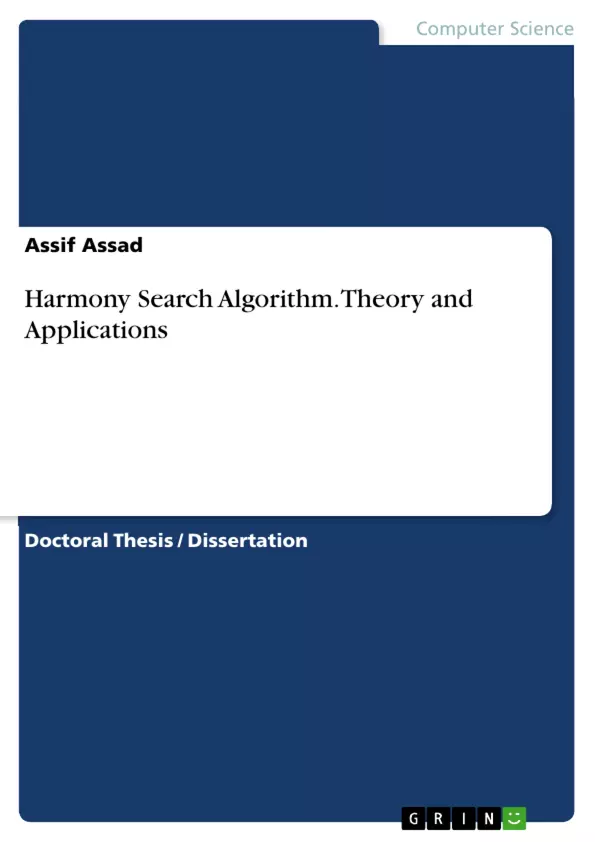The aim of this book is to introduce Harmony Search algorithm in the context of solving real life problems. Harmony Search (HS) is a musician’s behavior inspired metaheuristic algorithm developed in 2001, though it is a relatively new meta heuristic algorithm, its effectiveness and advantages have been demonstrated in various applications like traffic routing, multi objective optimization, design of municipal water distribution networks, load dispatch problem in electrical engineering, rostering problems, clustering, structural design, classification and feature selection to name a few.
Optimization is the process of finding the best alternate solution among a given set of solutions under some given constraints. The process of finding the maximum or minimum possible value, which a function can attain in its domain, is known as optimization. One of the most striking trends that emerged in the optimization field is the simulation of natural processes as efficient global search methods.
The natural processes or phenomena are firstly analyzed mathematically and then coded as computer programs for solving complex nonlinear real-world problems. The resulting methods are called Nature Inspired Algorithms that can often outperform classic methods. The advantages of these methods are their ability to solve various standard or application-based problems successfully without any prior knowledge of the problem space. Moreover, these algorithms are more likely to obtain the global optima of a given problem. They do not require any continuity and differentiability of the objective functions.
Also, they work on a randomly generated population of solutions instead of one solution. They are easy to program and can be easily implemented on a computer. Some of the examples of Nature Inspired Optimization Techniques are Genetic Algorithm, Particle Swarm Optimization, Artificial Bee Colony Optimization and Ant Colony Optimization.
Inhaltsverzeichnis (Table of Contents)
- Introduction
- Optimization
- Definition of an Optimization Problem
- Local and Global Optimal Solutions
- Methods for Global Optimization.
- Nature Inspired Computing Techniques
- The No Free Lunch Theorem
- Harmony Search Algorithm
- Harmony Search variants based on handling of parameter
- Improved Harmony Search
- Global Best Harmony Search
- Adaptive Harmony Search algorithm
- Self-adaptive Harmony Search
- Self-adaptive Global Best Harmony Search.
- Other variants of Harmony Search based on handling of parameters
- Variants based on hybridization of HS with other metaheuristic algorithms..
- Applications of Harmony Search Algorithm
- Motivation and Objectives of the Thesis
- Organization of the Thesis
- Developments in Harmony Search Algorithm
- Harmony Search variants based on handling of parameter
- Improved Harmony Search
- Global Best Harmony Search
- Adaptive Harmony Search algorithm
- Self-adaptive Harmony Search
- Self-adaptive Global Best Harmony Search.
- Intelligent Tuned Harmony Search Algorithm
- Improved Global-best Harmony Search
- Other variants of Harmony Search based on handling of parameters
- Variants based on hybridization of HS with other metaheuristic algorithms
- Applications of Harmony Search Algorithm
- Overview of Harmony Search Algorithm applications.
- A Hybrid Harmony Search and Simulated Annealing Algorithm for Continuous Optimization
- Introduction
- Simulated Annealing
- Proposed Hybrid Harmony Search and Simulated Annealing (HS-SA) algorithm
- Numerical Experiments on CEC 2014 benchmark suite
- IEEE CEC 2014 Benchmark suite
- Analysis of results
- Convergence Behaviour
- Wilcoxon rank test analysis
- Algorithm Complexity.
- Conclusion
Zielsetzung und Themenschwerpunkte (Objectives and Key Themes)
This work focuses on the Harmony Search (HS) algorithm, a metaheuristic optimization technique inspired by the improvisation process of musicians. It investigates the theoretical framework of HS, analyzes various modifications and applications of this algorithm, and proposes a new hybrid approach combining HS with Simulated Annealing (SA) for continuous optimization problems.
- Exploring the theoretical foundations and practical implications of the Harmony Search algorithm.
- Analyzing the effectiveness of different HS variants designed to address specific optimization challenges.
- Investigating the potential of hybridization strategies to enhance the performance of HS algorithms.
- Developing a novel HS-SA hybrid algorithm for continuous optimization and evaluating its performance on benchmark problems.
- Contributing to the advancement of nature-inspired optimization techniques for solving complex engineering and scientific problems.
Zusammenfassung der Kapitel (Chapter Summaries)
- Introduction: This chapter provides a comprehensive overview of the field of optimization, defining optimization problems, discussing different methods for global optimization, and introducing the concept of nature-inspired computing techniques. It presents the Harmony Search algorithm, its various variants, and its wide range of applications.
- Developments in Harmony Search Algorithm: This chapter delves deeper into the development of the Harmony Search algorithm, exploring its various variants based on handling parameters and hybridization with other metaheuristic algorithms. It highlights key improvements and advancements made to the algorithm over time.
- Applications of Harmony Search Algorithm: This chapter presents an overview of the diverse applications of the Harmony Search algorithm in various domains, showcasing its potential for solving real-world optimization problems.
- A Hybrid Harmony Search and Simulated Annealing Algorithm for Continuous Optimization: This chapter proposes a novel hybrid Harmony Search and Simulated Annealing algorithm for continuous optimization. It explains the integration of the two algorithms, describes the proposed HS-SA algorithm, and presents the results of numerical experiments conducted on benchmark problems.
Schlüsselwörter (Keywords)
This book centers on the Harmony Search algorithm, a powerful metaheuristic optimization technique that draws inspiration from the collaborative improvisation of musicians. The work delves into the theoretical framework of this algorithm, exploring its variants and applications in solving complex optimization problems. It further examines the potential of hybridizing HS with other optimization methods, such as Simulated Annealing, to enhance performance and achieve better results.
- Quote paper
- Assif Assad (Author), 2018, Harmony Search Algorithm. Theory and Applications, Munich, GRIN Verlag, https://www.grin.com/document/461697



